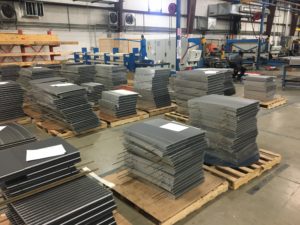Top 10 Obscure Facts About HVAC Coils
by Dan Jacobs, February 15, 2021
- HVAC Coils: When thinking about how they are built, there are only a few coil tool & die companies around the world. So, all coil manufacturers buy their tooling from the same companies. That obviously means that since all manufacturers use similar tooling, the idea that one company holds a major advantage over another because of better tooling is a serious misconception.
- The cost of copper is the main determinant of the cost of any coil as it takes up a massive percentage of any manufacturing costs. There are other materials involved, but they are minor in comparison when figuring out the overall cost. The cost of labor is relatively steady, so again this is why copper is THE determinant in coil pricing.

- Almost all coil manufacturers include freight to the jobsite as part of their quote – aka freight allowed. The reason that all manufacturers should do this is because geography also plays such a huge part in the cost of HVAC coils. Your cost ends up being an average of the total freight costs for all jobs, so if you are 100 miles from the plant, you are subsidizing other customers who might be located 2,000 miles from the plant.
- Crating is EVERYTHING! What good does it do to build a great coil, test it correctly, get it out the door quickly, and then crate it in such a terrible way that the freight company can easily abuse it in ways that we are all too well aware?
- Regarding freight companies, selecting one is more science than “educated guessing”. The #1 goal is to select a carrier that can deliver directly to your area/zone with as few stops in between as possible. Every time HVAC coils have to go through another terminal, switch trucks, and get forklifts put on it is another risk to damaging the coil.
- HVAC coils are covered in lubricants. You can’t expand the tubes or get a good fin/tube connection without using lubricants. Even though the coils are tested underwater for 20-30 minutes, there will still be lubricant residue on the coil when it arrives at the jobsite. It is perfectly normal, so no need to wonder is anything is leaking.
- Brazing coils is a really valuable skill, and good coil manufacturers (see Capital Coil & Air), never want to lose people who can braze. Women make terrific brazers because they traditionally have smaller hands and can braze into tighter spaces. In addition to their overall skill, that’s a large reason why female brazers in HVAC coil plants is a pretty common occurrence.
- Many coil manufacturers make the same mistake over and over again when they attempt to “low-ball” with pricing to fill up their plant with business. In theory, filling up your factory makes sense right? In this industry…no! In actuality, these manufacturers take on such a glut of business that when they are at or beyond capacity, lead times are greatly extended and/or emergency quick-ships are shut down for their best customers because their plant is full. More often than not, these changes occur with little or no advance notice to customers. Customers are people who come to your company for help with a problem, and they should never be treated as a “job”.
- Why are most coil plants located in very rural areas, in towns that most folks have never heard of? The answer in a single word is LABOR!!! Inverse of what one might believe, the cost of labor is less, while the quality of the labor is better and more dependable. The HVAC industry flourishes in these towns because workers show up on time, every day. We’re not comparing these areas to Silicon Valley, and while copper is still the main determinant of price, labor is still an integral part of the whole process.
Capital Coil has always believed that the better educated that you as a customer, and the better that you understand the overall coil business; your chances of selecting a quality manufacturer increase greatly. We’re happy to work with you on any and all jobs that come your way – contact us!
RELATED POSTS
How Did The HVAC Commercial Coil Replacement Market Originate???
OEM Replacement Coils: Repair or Replace???
